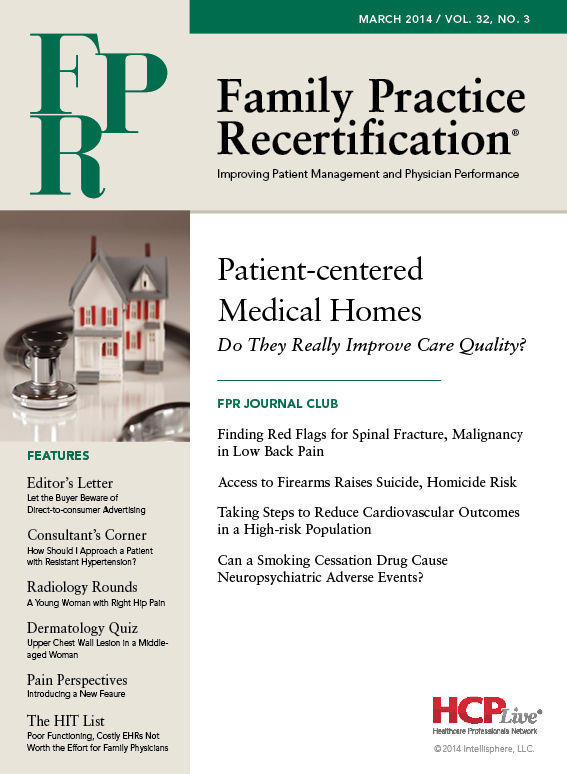Publication
Article
Family Practice Recertification
Let the Buyer Beware of Direct-to-consumer Advertising
Author(s):
Whether direct-to-consumer advertising is a good or bad thing remains a matter for debate, but what is not up for discussion is the need for due diligence on the part of physicians in managing patients who are motivated by those ads to seek medical attention.

Marin Quan, MD
Editor-in-Chief
Over the years, I have been struck by the growing number of male patients asking to get their testosterone levels checked at my practice.
Although requests for specific medications to treat disorders such as erectile dysfunction (ED), high cholesterol, allergies, nail fungus, heartburn, and insomnia have become relatively commonplace, requests to have a specific blood test remain somewhat of a surprise. In response to my query as to why they want this hormone checked, they indicate experiencing one or more nonspecific complaints — including fatigue, low energy, depressed mood, weight gain, increased body fat, reduced muscle mass and strength, and reduced libido — and hearing low testosterone (T) might be responsible.
Direct-to-consumer (DTC) advertising of prescription drugs has its roots in the early 1980s, when Merck & Dohme launched a campaign for its brand name pneumococcal vaccine, Pneumovax, and Boots Pharmaceuticals launched ads promoting its brand name non-steroidal anti-inflammatory drug, Rufen (ibuprofen). These actions stemmed at least in part from the rise of consumer and patients' rights movements advocating empowerment and active engagement in one’s own healthcare.
Ensuing restrictive and burdensome regulations implemented by the US Food and Drug Administration (FDA) in 1985 served to stunt the growth of DTC advertising, with pharmaceutical industry spending on those ads estimated at only $12 million in 1989. However, in 1997 and 1999, the FDA relaxed its restrictions, which allowed the use of a drug’s brand name and benefits in the same advertisement and granted manufacturers greater flexibility in how they provided the consumer with necessary information about the risks associated with their drugs. Those FDA actions coupled with a return on investment estimated as high as $4 in drug sales for every $1 spent on DTC advertising were responsible for the virtual explosion of broadcast and media ads that have followed, with well over $4 billion a year now spent by the pharmaceutical industry on this form of marketing.
Per the FDA, DTC advertising can be broken down into 3 categories: 1) product claim advertisements, 2) help-seeking advertisements like disease awareness announcements, and 3) reminder advertisements. Proponents argue the ads play an important educational role in public health by facilitating earlier recognition of undiagnosed medical disorders and motivating patients to learn more about their medical conditions and treatment options, and then consult their physicians about them.
However, critics of DTC advertising express concerns regarding the potential to undermine the doctor-patient relationship, convey misleading and biased information to a vulnerable public, and manipulate patients to request drugs they do not need. Whether DTC advertising is a good or bad thing remains a matter for debate, but what is not up for discussion is the need for due diligence on the part of physicians in managing patients who are motivated by those ads to seek medical attention.
This is of particular importance in the current wave of patients requesting their serum T levels to be checked. First of all, hypogonadism is just one factor in a long list of possible causes for a patient’s symptoms, and it is hardly the most common one. Second, if serum T is drawn, caution must be exercised in its interpretation, since the cut-off between normal and low T still has not been clearly established, particularly among aging males.
An even greater challenge looms if treatment is considered. Although T replacement has been shown to have value and is FDA-approved for men with abnormally low T levels and an associated medical condition, its role in patients with non-specific symptoms and T levels below the lower range of “normal” remains unclear. Finally, T hormone therapy is not without risks. In addition to the long-recognized risks of polycythemia and possible prostate cancer, recent studies warn of an increased cardiovascular risk, as well.
So, what to do for the patient who requests a serum T level check? Even in the midst of a busy day, it is important to not succumb to temptation and simply order the test; instead, make the time to take a thorough history, address the symptoms responsible for the request, and perform a pertinent physical examination. Following your evaluation, order the diagnostic tests you deem appropriate, and then only order a serum T test if you also suspect hypogonadism as a cause. Doing anything less runs the risk of placing yourself in the role of a short-order cook.
Martin Quan, MD
Editor-in-Chief
Martin Quan, MD, is Professor of Clinical Family Medicine and Director of the Office of Continuing Medical Education at the David Geffen School of Medicine at UCLA. He is also a member of the Education Advisory Board and consultant to the Committee on Continued Professional Development of the California Academy of Family Physicians and a member of the Kidney Learning System Advisory Board of the National Kidney Foundation. In the past, Quan has served as Program Director of the UCLA Family Practice Residency Program, Co-Director of the UCLA Pre-Doctoral Program in Family Practice, Editor-in-Chief of Clinical Cornerstone, and Vice Chair of the Residency Review Committee in Family Practice for the Accreditation Council for Graduate Medical Education (ACGME).





